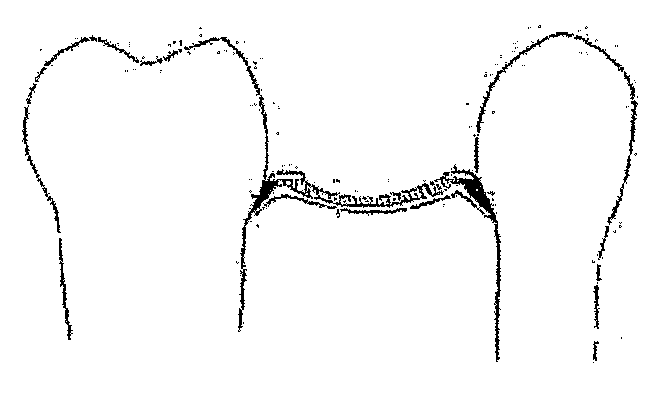Ceramic Reinforcement Bars For Direct Dental Bridge
a technology of cement reinforcement bars and direct dental bridges, which is applied in the field of cement reinforcement bars for direct dental bridges, can solve the problems of not being easy to perform, not being easy to place, and not being easy to bond well to dental filling materials and dental bonding resins, so as to facilitate the dentist's understanding of how, facilitate the placement of reinforcement bars, and facilitate the dentist's job. the effect of easy operation
- Summary
- Abstract
- Description
- Claims
- Application Information
AI Technical Summary
Benefits of technology
Problems solved by technology
Method used
Image
Examples
Embodiment Construction
[0125] The effort so far has been to try to find a way to reinforce a direct bridge that is placed directly in the mouth without assistance from a laboratory. However, the same principles that have been used in my direct bridge placement can also be used for a laboratory-processed bridge. An embodiment of my invention for the laboratory-processed bridge would be to use the reinforcement structures of Zirconia or Alumina or a combination of both for a laboratory processed bridge.
[0126] Examples of the laboratory-processed bridge can be seen in Diagrams 24a-24d.
[0127] Diagram 24a shows a pontic with a rectangular zirconia bar through the middle of the pontic and the proximal ends of zirconia bar cemented into a cavity preparation in the mesial distal of the abutment teeth. Possible cross sections of this bar can be seen in 24c and 24d; however numerous cross-section designs to aid in retention of the pontic could be manufactured.
[0128] Diagram 24b shows either two possibilities whe...
PUM
| Property | Measurement | Unit |
|---|---|---|
| width | aaaaa | aaaaa |
| width | aaaaa | aaaaa |
| diameter | aaaaa | aaaaa |
Abstract
Description
Claims
Application Information
 Login to View More
Login to View More - R&D
- Intellectual Property
- Life Sciences
- Materials
- Tech Scout
- Unparalleled Data Quality
- Higher Quality Content
- 60% Fewer Hallucinations
Browse by: Latest US Patents, China's latest patents, Technical Efficacy Thesaurus, Application Domain, Technology Topic, Popular Technical Reports.
© 2025 PatSnap. All rights reserved.Legal|Privacy policy|Modern Slavery Act Transparency Statement|Sitemap|About US| Contact US: help@patsnap.com



